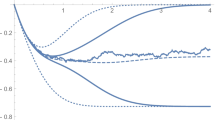Abstract
The best known result about the joint distribution of the backward and forward recurrence times in a renewal process concerns the asymptotic behavior for the tail of that bivariate distribution. In the present paper we study the joint behavior of the recurrence times at a fixed time point t, and we obtain both exact results and bounds for their joint tail behavior. We also obtain results about the joint moments of these two random variables and we show in particular that the expectation of the product between the two recurrence times increases with time when the interarrival distribution has a decreasing failure rate. The results are illustrated by some numerical examples.
Similar content being viewed by others
References
Barlow RE (1996) Mathematical theory of reliability. SIAM (Classics in Applied Mathematics)
Belzunce F, Ortega E M, Ruiz J M (2001) A note on stochastic comparisons of excess lifetimes of renewal processes. J Appl Probab 38:747–753
Boxma O (1984) Joint distribution of sojourn time and queue length in the M/G/1 queue with (in)finite capacity. Eur J Oper Res 16:246–256
Brown M (1980) Bounds, inequalities, and monotonicity properties for some specialised renewal processes. Ann Probab 8:227–240
Brown M (1981) Further Monotonicity Properties for Specialized Renewal Processes. Ann Probab 9:891–895
Chen Y-H (1994) Classes of life distributions and renewal counting processes. J Appl Probab 31:1110–1115
Coleman R (1982) The moments of the forward recurrence time. Eur J Oper Res 9(2):181–183
Constantine AG, Robinson NI (1997) The Weibull renewal function for moderate to large arguments. Computat Statist Data Anal 24:9–27
Feller W (1971) An introduction to probability theory and its applications, vol II, 2nd edn. Wiley, New York
Gakis KG, Sivazlian BD (1992) The use of multiple integrals in the study of the backward and forward recurrence times for the ordinary renewal process. Stoch Anal Appl 10(4):409–416
Gakis K G, Sivazlian B D (1993) A generalization of the inspection paradox in an ordinary renewal process. Stoch Anal Appl 11(1):43–48
Gakis K G, Sivazlian B D (1994) The correlation of the backward and forward recurrence times in a renewal process. Stoch Anal Appl 12(5):543–549
Gupta R C (1984) Some characterizations of renewal densities with emphasis in reliability. Statistics 15:571–579
Gut A (2009) Stopped random walks: Limit theorems and applications. Springer-Verlag, New York
Li X, Kochar S C (2001) Some new results involving the NBU(2) class of life distributions. J Appl Probab 38:242–247
Losidis S, Politis K (2017) A two-sided bound for the renewal function when the interarrival distribution is IMRL. Stat Probab Lett 125:164–170
Losidis S, Politis K (2019) The covariance of the backward and forward recurrence times in a renewal process: the stationary case and asymptotics for the ordinary case. Stoch Model 35:51–62
Psarrakos G, Politis K (2012) The covariance between the surplus prior to and at ruin in the classical risk model. ASTIN Bull 42(2):631–653
Resnick S (1992) Adventures in stochastic processes. Bikhäuser, Boston
Shaked M, Shanthikumar J G (2007) Stochastic orders. Springer, New York
Shaked M, Zhu H (1992) Some results on block replacement policies and renewal theory. J Appl Probab 29:932–946
Willmot GE, Lin X (2001) Lundberg approximations for compound distributions with insurance applications. Springer, New York
Acknowledgments
The authors wish to thank the referee for their valuable and constructive comments, which improved the presentation of the paper.
Author information
Authors and Affiliations
Corresponding author
Additional information
Publisher’s Note
Springer Nature remains neutral with regard to jurisdictional claims in published maps and institutional affiliations.
Rights and permissions
About this article
Cite this article
Losidis, S., Politis, K. & Psarrakos, G. Exact Results and Bounds for the Joint Tail and Moments of the Recurrence Times in a Renewal Process. Methodol Comput Appl Probab 23, 1489–1505 (2021). https://doi.org/10.1007/s11009-020-09787-w
Received:
Revised:
Accepted:
Published:
Issue Date:
DOI: https://doi.org/10.1007/s11009-020-09787-w
Keywords
- Renewal process
- Renewal density
- Forward recurrence time
- Backward recurrence time
- Spread
- Joint moments
- Failure rate
- Upper orthant stochastic order



